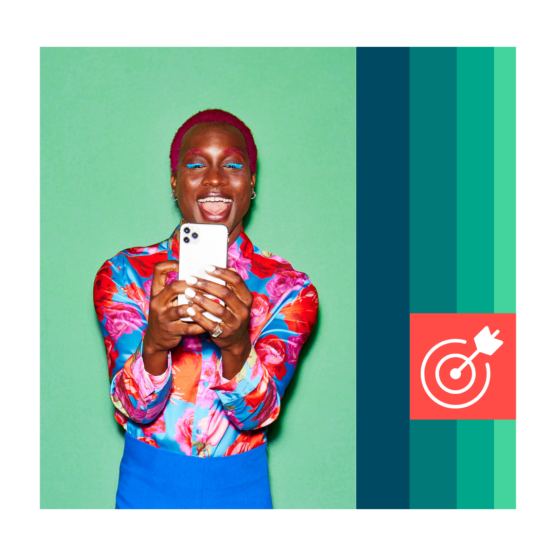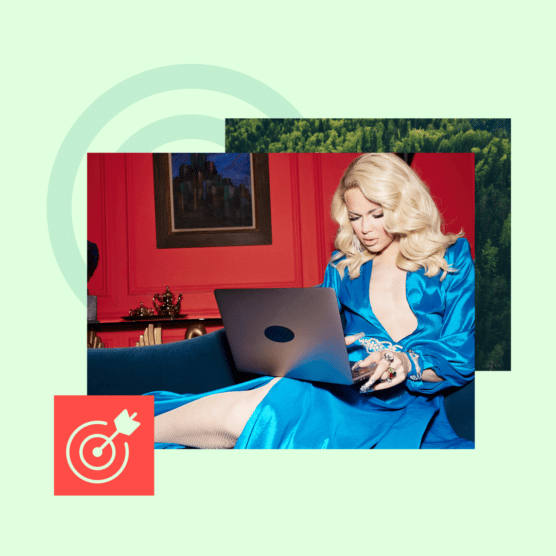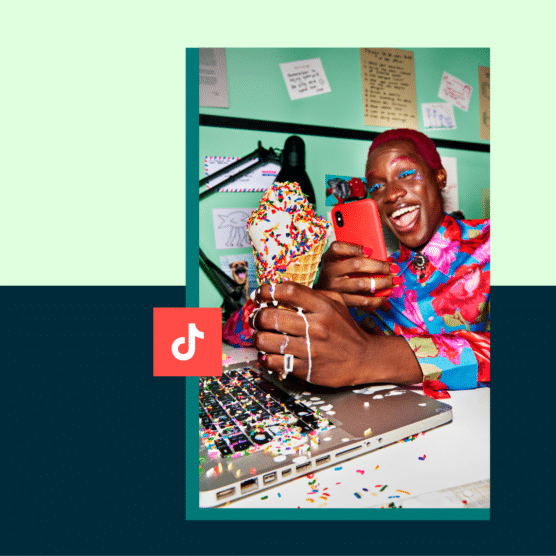Got some cool new clothes that you’re ready to show off to the world? Chances are you’ll snap a pic and post it on your social profiles. Maybe you’ve received a fancy new product and want to post an unboxing video to your YouTube channel. Whether you know it or not, both of these examples are user-generated content (UGC).
Still confused? Don’t worry; we’ve got you covered.
In this article, you’ll learn what user-generated content is, plus a few other things:
- Understand the benefits of using UGC in your campaigns
- See how big and small brands execute UGC
- Get actionable tips to help transform your user-generated content into more engagement and conversions for your brand
What is user-generated content (UGC)?
User-generated content (also known as UGC or consumer-generated content) is original, brand-specific content created by social media users and published on social media or other channels.
UGC can take many forms, including images, videos, product reviews, testimonials, or even podcasts.
Here’s an example of UGC created by a customer and then reshared on planner Day Designer’s Instagram:
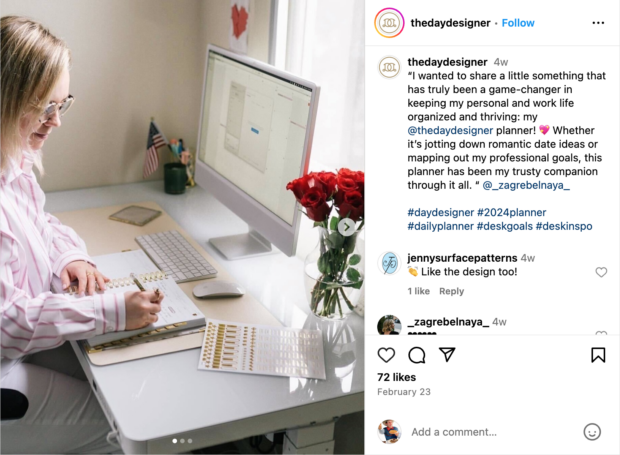
Source: thedaydesigner on Instagram
Types of user-generated content
User-generated content is becoming an important part of many marketing strategies, and it comes in many styles and formats to help you find the right fit for your brand.
However, there are two main overarching types: organic UGC and paid UGC.
Organic UGC
Organic UGC is content that your real-life customers share freely. It’s the most authentic type of UGC and what you hope to see from your customers.
Reviews and testimonials
Online reviews count as a type of UGC. Positive ratings and reviews can be shared across your website and social media as social proof. Brands can even turn testimonials into little graphics they can share on their social media accounts.
Photos
Photos, of course, are one of the most common types of UGC. This typically looks like an image of a customer using your product or sharing their results from your product. Using a hashtag to help collect these makes it easy to find and reshare them on your own platforms.
Videos
Social media and YouTube videos can also be great forms of UGC. In fact, many YouTubers will share “product hauls” of items they bought recently, featuring several brands in a single video. Share that video—or the snippet mentioning your brand—to showcase what they have to say about your product.
Social media content
Sometimes, even a simple positive mention of your brand can be great content to reshare. Repost if you’re on X (Twitter), or take a screenshot and share it as a graphic on a platform like Instagram.
Blog posts
Bloggers may also mention your brand or product in one of their blog posts. This could be a standalone review or a swift mention in a broader post. Consider sharing their quote on social media or your website to spread the word.
Paid UGC
The other main type of UGC is paid UGC. This is becoming increasingly popular, especially for newer brands that want to share this type of content but don’t have enough customers sharing photos yet.
Paid UGC is made by UGC creators. This is different from influencers and is typically just as sincere as regular UGC — you’re just footing the bill.
You can reach out to UGC creators on your own, using a platform like Fiverr or Upwork, but if your brand has fans already, creators may come straight to you.
Either way, once you’ve sorted out a deal, you can take the content they create and share it on your website or social media accounts as user-generated content.
Why user-generated content is important
UGC is used across all stages of the buyer’s journey to help influence engagement and increase conversions. This customer-centric content can be used on social media and other channels, such as email, landing pages, or checkout pages.
Authenticity
Nowadays, brands have to fight to be seen online, and competition is fierce for audience attention. Buyers are more selective about the brands they interact with and purchase from.
However, no other content type is more authentic than UGC from your customers. 86% of consumers are more likely to trust a brand that shares UGC compared to 12% who are likely to purchase a product promoted by influencers.
Just don’t be tempted to fake your user-generated posts or marketing campaigns. Audiences will quickly sniff out the false sentiment, which could damage your brand reputation. Instead, always ensure that your UGC comes from one of three cohorts: your customers, brand loyalists, or employees.
Think of UGC as the modern-day word of mouth — most people trust recommendations over straight-up advertising.
Brand loyalty
People thrive off being part of something bigger than themselves, and creating UGC allows them to be part of a brand’s community. That’s huge for boosting brand loyalty and affinity.
UGC also opens up conversations between a brand and consumer, and this level of brand interaction helps build and grow an engaged community.
Sharing audience content also works to develop and deepen audience/business relationships, driving more brand loyalty.
Social proof
Remember when Fyre Festival was marketed as an “immersive music festival over two transformative weekends,” but the event was actually rain-soaked tents in a field with no electricity or food? This is why people don’t trust marketers or advertisers.
In fact, only 32% of Americans have a “fair amount” or “great deal” of trust in the media, a record low since 2016.
Brands need to work harder than ever to establish themselves as trustworthy. And social proof is one way to do that. Social proof is a psychological phenomenon that makes people want to do what others enjoy.
UGC is the perfect example of this. When potential customers see existing customers happy with your product, they’re psychologically more likely to try it for themselves.
Content curation
UGC doesn’t have to be limited to social media marketing, either. UGC content can also be used on other channels.
For example, try adding UGC images to a cart abandonment email to help nudge the prospective buyer to purchase. You might also add user-generated content to key landing pages to help increase conversion rates.
Calvin Klein even created a landing page just for UGC content.
By showing real examples of customers styling their Calvins, shoppers see other consumers endorsing the brand and showcasing how the products look on actual humans instead of overly styled models.
Cost-effectiveness
The average cost of hiring an influencer can run into millions of dollars. But the average cost of asking your customers to share posts of them enjoying your product? Next to nothing.
UGC is a cost-effective way to scale your business and diversify your content. Plus, there’s no need to invest dollars in expensive ad agencies or flashy campaigns.
UGC allows you to connect with the most important people in your business: your audience. Most will be excited to be featured on your channel.
For smaller brands or those just starting out than investing in larger-scale brand awareness campaigns, UGC is often far cheaper and easier to manage.
5 great examples of user-generated content
No matter their size, brands use user-generated content to drive awareness, increase conversions and social engagement, expand their reach, and cost-effectively grow their business.
GoPro
Video equipment company GoPro uses UGC to sustain its YouTube channel, with its top three videos all originally filmed by customers. As of March 2024, those three videos have racked up over 400 million views combined.
Not bad for content that cost GoPro nothing to produce.
In fact, UGC for the company got so big, they now run their own awards show and promote daily photo challenges to inspire their consumers to get creative.
lululemon
Canadian athleisure brand lululemon is primarily known for its expensive leggings and yoga clothing. To increase company reach across social media, they asked followers and brand loyalists to share photos of themselves in lululemon garments using the hashtag #thesweatlife.
Not only did this result in a treasure-trove of easily searchable UGC content for lululemon to repurpose, but it also organically expanded the company’s brand awareness and reach across social media as they shared content from brand ambassadors.
This post, in particular, is motivating and exciting to its audience as it shares some of lululemon’s ambassadors’ best moments of 2023:
LaCroix
In a similar strategy to lululemon, sparkling water brand LaCroix also uses a hashtag (#LiveLaCroix) to mine for UGC on their social media channels. However, LaCroix relies less on brand loyalists and shares content produced by anyone, no matter their follower count.
This makes their user-generated content hyper-relatable because audiences see themselves reflected in these photos rather than brand ambassadors or loyalists with higher follower counts.
Well Traveled
UGC isn’t just for larger, well-established brands. Smaller companies also use UGC in their social campaigns. Well Traveled is a community-driven travel brand that uses member-generated content to highlight the perks of membership, the quality of property partners, and other exclusive offerings from brand partners.
Well Traveled’s Director of Partnerships & Brand Marketing, Laura DeGomez, says, “As a service in such a visual industry, the ‘proof’ provided by member content is immeasurable. The beautiful trips discovered, planned, and booked on Well Traveled are a phenomenal marketing and retention tool.”
DeGomez uses UGC to visually engage members or prospective members and increase brand awareness, expand reach, and build community.
She goes on to say, “No one tells our story better than our members. The Well Traveled community is the key here. Whenever we can let their experiences shine, we do.”
Edloe Finch
Boutique furniture brand Edloe Finch collects UGC via hashtag (#EdloeFinch), but they also allow people to submit their photos to their website. The brand then showcases these customer photos right on their product pages.
By placing customer content on its product pages, potential customers can see what Edloe Finch’s products look like in other customers’ homes. Purchasing furniture online can be nerve-wracking, but these photos serve as a great form of social proof.
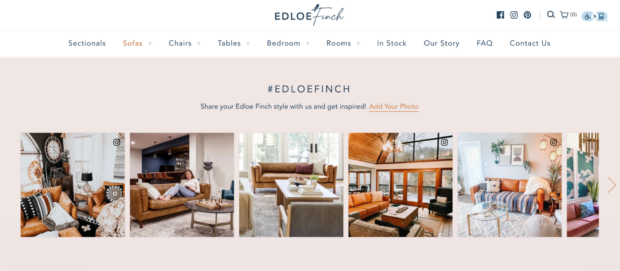
Source: Edloe Finch
4 best practices for user-generated content
Creating user-generated content is a smart strategy for your business. Keep these best practices in mind as you implement UGC into your overall content plan.
Always request permission
Consent to share content is mandatory. Always ask before republishing or using a customer’s content.
People may use your branded hashtags without necessarily knowing you’ve tied them to a user-generated content campaign. Unfortunately, re-sharing that content without explicit permission is a surefire way to kill goodwill and annoy some of your best brand advocates.
When you ask permission, you show the original poster that you appreciate their content and get them excited about sharing their post with your audience. You also keep yourself out of hot water regarding copyright concerns.
Credit the original creator
When you share user-generated content on your social media channels, give clear credit to the original creator. This includes tagging them directly in the post and indicating whether you’re using their visuals, words, or both. Always give credit where credit is due.
If you plan to share user-generated content across social media platforms, check for how the creator wants to be credited on the various channels. For example, if you want to share a photo from Instagram on your Facebook page, ask the original creator if they have a Facebook page you could tag.
Providing proper credit is an important way to recognize the work of content creators. It helps make sure they stay excited about using and posting about your brand.
It also makes it easy for fans and followers to verify that the content was created by someone outside your company.
Be clear about what kind of content you’re looking for
UGC creators want you to share their content. That means they want you to tell them what kind of content you’re most likely to share.
Don’t be afraid to get specific and make it easy for people to share content that fits your needs.
Be strategic and set goals
How will you know what type of UGC content to ask for if you don’t know how it fits in with your campaign strategy? Sure, it’s nice when people tag you in pretty pictures, but how can you use that content to support your marketing goals?
Firstly, sit down with your social media strategy document and look for ways UGC aligns with your existing marketing goals. Then, create a simple statement based on that information that tells users specifically what kind of content you’re most likely to feature.
Once you have a clear UGC ask, share it anywhere people are likely to interact with your brand:
- Your bios in social channels
- Other user-generated posts
- Your website
- Your physical location
- Your product packaging
UGC strategy goes beyond understanding the types of content you need from your customers. You also need to align your UGC campaign with broader social media goals.
For example, are you looking to increase brand awareness or drive more conversions (or both)?
Measure the success of your campaigns using a tool like Hootsuite Analytics or a social listening tool such as Hootsuite Listening to understand brand sentiment and trust.
Ready to start displaying authentic user-generated content across your social channels? Use Hootsuite to publish and schedule posts, find relevant conversions, engage the audience, measure results, and more. Try it free today.
With files from Chloe West.
